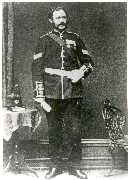John Murray
Biography | Medals | Citation | GlossaryBiography
At the end of 1863, the 68th Light Infantry was ordered to set sail for New Zealand, where the Maoris had gone to war to try to halt the spread of the British settlements on North Island. The Regiment landed at Auckland in January 1864. Over two hundred of the soldiers, including John Murray, were veterans of the Crimean War.
The Maoris were brave and skilful soldiers and on 29th April 1864, a mixed British force of soldiers and sailors attacked Gate Pah (a Maori fort of trenches and wooden stockades), whilst the 68th Regiment waited behind the fort to prevent any escape. Despite a fierce artillery bombardment, the attack failed and the storming party was driven off with heavy losses. During the night, the Maoris abandoned the pah and slipped away through the 68th's lines.
A few weeks later, on 21st June 1864, a British force of eight hundred soldiers, mostly from the 68th, came across a force of six hundred Maoris building a new pah at Te Ranga, a few miles inland from Gate Pah. The British attacked, storming the unfinished defences. In the ferocious hand to hand fighting, Sergeant Murray, using his bayonet, killed or wounded at least eight Maori soldiers in a rifle pit, rescued John Byrne VC from certain death and continued to fight his way deep into the pah.
After the battle, Colonel Henry Greer of the 68th, who had led the entire British force, wrote his report -
"I must not conclude without remarking on the gallant stand made by the Maoris in the rifle pits; they stood the charge without flinching and did not retire until forced out at the point of the bayonet."
He also gave details of individual soldiers, including -
"Sergeant John Murray, whose gallantry and prowess were so distinguished, I have thought him worthy of being recommended for the Victoria Cross."
The London Gazette announced the award of the Victoria Cross to Sergeant John Murray on 4th November 1864 "for his distinguished conduct". [citation] It was presented to him at Wanganui on 5th December 1865 by Brigadier-General Waddy, whilst the Regiment was still in New Zealand.
With his Army career coming to an end, Sergeant Murray transferred in 1872 to the 2nd North Durham Militia in Durham City, for his final year. On his discharge in February 1873, aged forty-two years and after twenty-one year's service, he was described as being nearly 6' tall, with blue eyes, dark brown hair and a fresh complexion.
John Murray returned home to Ireland following his discharge. As little, unfortunately, is known about his later life as about his childhood. He died, a widower, at his sister's house at Derrinlough near Birr, on 8th April 1911, aged about eighty years and was given a full military funeral at Eglish graveyard with a firing party from the local barracks at Birr and a band from the Leinster Depot.
Note: John Murray's VC is incorrectly dated on the reverse - "June 24 1864" instead of 21 June 1864, the actual date of the battle at Te Ranga. This was the third VC awarded to the Regiment & the last until the Great War.
See "Beyond Praise. The Durham Light Infantrymen who were awarded the Victoria Cross" by Stephen D Shannon, 1998, ISBN 1 897585 44 6. This has a foreword by Richard Annand VC.
Return to DLI Collections home page.
